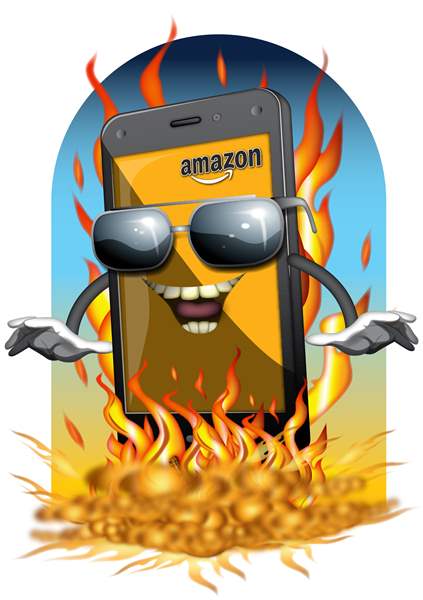
Amazon’s Fire phone sizzles, but won’t set the world on fire
6/21/2014
BLADE ILLUSTRATION BY TOM FISHER

SEATTLE — When Amazon invited the media and hundreds of its most loyal customers to witness the unveiling of a new device Wednesday, everyone thought the company would introduce a smart phone made in the mold of its line of tablet computers: pretty good and really cheap.
Everyone was wrong. Although the device is called the Fire phone, Amazon’s new gadget is less a phone than a pocketable cash register hooked directly into the retailer’s intelligent warehouses. And it’s not cheap. The Fire phone sells for $199 with a two-year AT&T contract. Although it also comes with a free one-year subscription to Amazon’s Prime membership, the Fire phone is essentially the same price as high-end phones made by Apple and Samsung.
The world needed a great, cheap smart phone. With its huge reach, obsessive dedication to customer service, and a willingness to forgo immediate profits, Amazon seemed uniquely capable of delivering such a device.
But instead of a cheap phone, Amazon delivered a device packed with many high-end, whiz-bang features. It’s hard to see what this phone offers over the iPhone, the Samsung Galaxy, or any other top-of-the-line smart phone on the market today.
“It’s a really premium phone,” Jeffrey Bezos, Amazon’s founder and chief executive, said when asked during an interview about the phone’s price. “We’ve packed a lot of hardware and expensive material in.”
Mr. Bezos declined to say whether the company would make a profit on each phone sold. In the past, the company has eschewed that model of hardware sales. But he said the Fire phone’s technological capabilities made it a bargain at its price.
It’s true that the Fire phone has several novel features. Among them is an image-recognition system, Firefly, that will let you identify any book, movie, phone number, or other object you point at with your phone. Firefly is the heart of the phone’s connection to Amazon’s shopping engine. Aim the device at anything around your house, like a bag of cat litter or a tube of toothpaste, and the phone instantly recognizes what it is and gives you an option to buy the item and have it delivered immediately. During a short demonstration with the phone, which is available for order now and will ship July 25, I found that feature to be eerily accurate. It flawlessly recognized pretty much everything I pointed to, offering me a way to buy something on the fly — from Amazon.
Mr. Bezos pushed back against the idea that there was anything nefarious about this connection to Amazon’s store.
“Helping people take care of their shopping tasks is an important job to do in any smart phone,” he said. “But that’s not what the phone is all about.”
He added that it would be “too simplistic” to call the phone simply a vehicle for selling Prime memberships, although he conceded that Prime members would get a lot out of this device.
The Fire has an innovative 3-D display that adds a sense of perspective to some of its user-interface screens. The system also allows you to scroll or browse through content by tilting the phone in certain ways. That feature leans more toward the gimmicky than the useful, but not in an annoying way. It does not slow down or otherwise interrupt how you use the device, but I’m not sure that it will add much, either. On the other hand, it does look pretty cool.
Amazon has included two features that are unusual and useful. One is Mayday, Amazon’s live video customer service, which it began offering on its Kindle Fire tablets last year. The feature lets you call up an instant, on-screen video chat with a customer service representative at the push of a button.
Even the best, easiest-to-use smart phones can sometimes be vexing. How do you connect your phone to both your work and personal calendar? How do you get on your company’s virtual private network? What’s the best way to send your mother a dozen full-resolution photos? With Mayday, help is immediate and delightful.
The other fantastic Fire phone feature: Every photo you snap on the phone is backed up on Amazon’s servers free. There’s no limit to how many photos are stored there. It’s a simple, headache-free backup system that I wish every other phone manufacturer offered — Apple most urgently.
And yet, despite these distinctions, Amazon’s phone suffers severe shortcomings compared with similarly priced rivals. Its app store doesn’t have anywhere near the number of third-party programs currently available on the iPhone or Android devices. There are more than 200,000 apps in Amazon’s store, but almost all are designed for the firm’s tablets. IOS and Android have app stores approaching 1 million titles.
More challenging than the app shortage is the phone’s novel user interface. While the Fire phone looks simple, it’s thoroughly new. People who are used to iOS and Android will need to figure out new ways to get around this device. But most people who are looking at a phone at this price are most likely already used to one major phone platform or another. Amazon is asking them to learn something new, without much of a financial benefit for doing so.